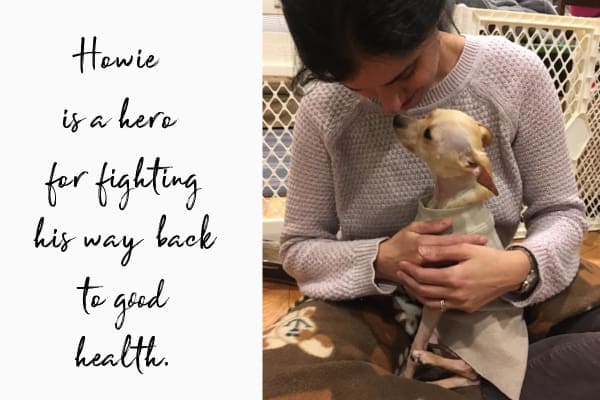
Photo credit: Dr. Shelly Kamath Pancoast.
This is the real-life story of a dog named Howard who demonstrated initially subtle (but rapidly escalating) signs of pain associated with a sudden tear of his stomach. The videos below (along with pictures and descriptions) are a powerful illustration of
Howard’s backstory
Weeks prior to this episode, Howard had experienced unexplained back pain. (For a deep dive into the anxiety-pain connection, please read my article: Chronic Pain in Dogs—An Interview with Dr. Ralph Harvey. ) His critical care veterinarian (who also happens to be his owner) took Howard to a neurologist for advanced imaging in the quest for a diagnosis.
Our little protagonist had three MRIs, cerebrospinal fluid taps, and extensive bloodwork. Everything came back normal. His diagnosis remained a mystery, yet Howard continued to deteriorate.
A painful dog and a mom’s quick actions
Finally, Howie’s pain became so severe that he started biting his humans. Humane euthanasia was on the table due to the intensity of Howie’s pain, but neurologist Dr. Lauren Marini proposed administering immunosuppressive doses of prednisone and a chemotherapy drug called Cytosar.
Six hours into the 24-hour infusion of Cytosar, Howie was almost back to normal. In light of the progression of
The first video below of Howie (wearing a red harness) was taken immediately after he perforated his stomach. Just 30 seconds prior, he had been totally normal—playing and jumping.
When he became acutely painful, his mom began videotaping the episode, thinking it would be helpful for the neurologist to see Howie’s behavior. She had no idea what was really wrong with her dog.
Howard’s painful condition quickly escalated
But after he vomited, his astute ER vet mom realized that his symptoms were pointing to an “acute abdomen” (translated as belly emergency). In hindsight, the high doses of prednisone had likely predisposed him to this issue.
His mom’s decisive, quick actions saved his life. She rushed him to the specialty facility where she works; he was in surgery within three hours of the video footage that was captured of him (see below). The stomach tear was identified and repaired.
Three days later, Howie was back home with his family.

Photo credit: Dr. Shelly Kamath Pancoast.
7 Signs of pain in dogs
We can learn a lot from Howie’s story and his videos. Recognizing signs your dog is in pain and promptly seeking veterinary care might just save your dog’s life one day.
1. Disengaging from the family and decreased activity level
Dogs may exhibit signs of pain by secluding themselves, often subtly, as a means of protection. Watch for:
- Apprehensiveness about being held
- Hiding behind or under furniture
- Unwillingness to be part of family activity
- Reluctance to rise, lie down, and/or walk
- Avoiding or struggling on stairs
- Reluctance to jump up on couch/beds
2. Change in facial expression and ear carriage
While dogs can’t tell us where it hurts, they do express pain through their facial expressions and ear placement. In the photo below, Howie is exhibiting classic signs of pain through his facial expression. In your dog, watch for:
- Ears laid back
- Eyes hard or squinted
- Pupils dilated
- Grimacing consistent with facial muscle contraction

Photo credit: Dr. Shelly Kamath Pancoast.
3. Abnormal posture and gait
Your dog may exhibit physical signs of pain through a change in posture or the way he carries himself. In the video below, Howard’s
- Tail tucked or held awkwardly
- Hunched appearance or c
urved topline - Abnormal stretching (as seen in the video)
- Inability to sit or lie comfortably/restlessness
- Limping/favoring a leg
- Unwillingness to lift head or turn neck
Video credit: Dr. Shelly Kamath Pancoast.

This dog is carrying his head low, which can indicate neck pain.

4. Vocalizing: The pinnacle of pain in dogs
Please note that points 3 and 4 in this list of signs of pain in dogs are placed in this order on purpose. When I initially saw Howie’s video above, I knew it was the perfect way to visually dispel the myth that a dog in pain will cry or moan. Granted, this does happen, as exhibited in the next video of Howie, but a dog crying in pain is the exception to the rule, not the rule. Most dogs suffer silently.
However, if you do observe the following vocalizations from your dog, contact your veterinarian immediately:
- Dog crying in pain
Dog howling, groaning, or whining in a way that is consistent with distress- Dog whimpering in pain
Howard showed signs that his pain was becoming more severe and began vocalizing in distress.
Please note, the following video may be disturbing to watch. Howie’s mom captured the video to share with the neurologist before she realized how serious his condition was. Again, if you find this disturbing, you may want to skip this video which illustrates a dog crying in pain.
WARNING—Graphic Video: Dog vocalizing in pain
In this video, in addition to crying, we see Howie stretching again, flattening back his ears, and demonstrating an inability to get comfortable due to pain.
Video credit: Dr. Shelly Kamath Pancoast.
5. Changes in behavior or habits
Changes in your dog’s behavior are worth noting. When a dog stops doing something that he’s always
- Change in appetite (typically decreased)
- Uncharacteristic signs of aggression
- Loss of housebreaking
- Sleep/wake cycle changes/restlessness at night
- Shaking or trembling

6. Self licking or biting
In the videos, you may have noticed Howie turning to nip at his flanks. Dogs often bite at, gnaw on, or lick parts of their bodies that hurt. Here are some examples:
- Dogs with arthritis may obsessively lick painful joints or limbs.
- In some cases, lick granulomas (a self-inflicted sore from incessant licking) can be linked to nerve pain. For example, lick granulomas on the front legs may be linked to cervical disc disease.
- Dogs can bite at their tail as a response to pain in the hind end.
7. Increased heart and respiratory rates
The previous six points are all subjective, meaning that they are based on human opinion. Heart rate and respiratory rate are objective measures of pain in dogs. They can be quantified and aren’t affected by human bias.
When a dog is in pain, his or her heart rate and breathing will increase. If you’ve ever been in acute pain, you recognize that the same is true for humans. Dogs in distress often pant.
To learn more about your dog’s normal vital parameters so you can recognize abnormalities, please check out my podcast: Learn Your Dog’s Normal Vital Signs.
A happy ending for Howard
As you can see in the video below, Howard recovered quickly and is playing again—without pain!
Video credit: Dr. Shelly Kamath Pancoast.

Photo credit: Dr. Shelly Kamath Pancoast.
A letter to Howard from his family
Thanks to Howie’s mom’s swift action, the numerous veterinarians who provided him excellent care at Ocean State Vet Specialists and Bay State Veterinary Emergency and Speciality Services, and the deep pockets of pet insurance, Howie made a full recovery. I absolutely love this note that his family wrote him on social media:
Dear Howard,
Thank you for not dying from MUE or your septic abdomen.
Love,
Your Family
Howie is a hero for fighting his way back to health and for exemplifying signs your dog is in pain. His mom, Dr. Shelly Pancoast, and I post his story and videos here in the hope that they will help other dog owners recognize and react quickly to pain in their own dogs.
What questions do you have about signs of pain in dogs?
Please comment below. We can all learn from each other.


my dashound dog has yelped a couple off times but don’t know why but don’t seem himself
Hi Joanne,
I understand why this has you concerned. It would be a good idea to have your Dachshund evaluated by your vet. Hoping you can get some answers and ensure your sweet pup is happy and healthy.
My dog is usually very calm.
He’s acting strange !
He suddenly stiffs up and try’s to get away from me,
After a while he’ll lay down and sleep.
He’s also drooling a lot.
Hi Nancy,
The symptoms you are describing have me concerned. I think it would be best to err on the side of caution and have your dog examined by your vet. Hoping all is well today. Praying for a positive outcome.
What to give my dog for his pain
Hi Coshan,
It is hard to know what medication would be best for your dog without knowing what is causing his pain in the first place. I recommend having your pup examined by your vet. They should be able to tell you what will work best for your dog’s specific situation.
Some of the signs listed (Hiding behind or under furniture, Eyes hard or squinted, Tail tucked or held awkwardly, Inability to sit or lie comfortably/restlessnes and Change in appetite) our dog had prior to being diagnosed with presumed HSA. She was found with spleenic tumor, possible lung metastasis and anemia. I’ve read HSA does not cause pain but the change in our dog’s disposition told me something was wrong. She did suffer :(( but thankfully we didn’t prolonged her pain. Thank you for this helpful article.
Dear Dinah,
I am sorry for the loss of your sweet girl. I know it doesn’t change the past, but I am glad the article was informative and gave you some insight as to what you witnessed with your pup. I hope with time your heart will heal and you will be comforted by the memories of all the good times you shared. Thank you for sharing your story with us. Bless you.
I was surprised that a vet would have pet insurance. It’s my understanding that vets get deep discounts on products and services for their own animals, and in a the-house-always-wins way I figured it’s more often *not* worth it (and perhaps this is because I adopt seniors, or very adult dogs). In your experience, is it generally worth the cost? My quick math usually has me breaking even when I get the urge to get a quote.
Hi Jessicah,
I am glad you opened up the floor for this discussion! Pet insurance can be extremely valuable for many pet owners. You are correct that for some it may not be worth the cost. This all depends on the individual dog. Pet insurance is exactly like health insurance for humans. If you are fairly healthy you will probably pay more into it than you will get out of it. But, on the flip side, if you have a health crisis or have chronic health issues, you might not be able to afford the cost of health care without insurance. So, paying for insurance, whether in human medicine or veterinary medicine, is all about the “what ifs” and trying to predict what could happen in the future. As far as veterinarians getting deep discounts….I guess it depends on your point of view. You are correct that most vets do not have to pay for an exam or services such as nail trims, anal gland expressions, ear cleanings, etc. because they perform these themselves on their own pets. If a vet does not work in general practice, then when they take their dog to a general practice facility, they pay the same price as any other client. Employees at a veterinary facility usually get some sort of employee discount on products as a benefit just as an employee would at any other business or store. Make no mistake, even as a vet, if we take our dogs to a specialty hospital or referral center, we are paying the same prices as other clients. Health care (no matter the species) is not cheap. I hope that sheds some light on this topic. I always welcome the opportunity to provide information!
Thank you so much, Dr. Buzby, for sharing this story!! My dog, a pom and chihuahua mix, was exhibiting similar behaviors as Howard, except no vomiting or diahrea. She’s also eating normally. She’s had these episodes twice today and I’m not sure what’s causing it. After the episodes which last 5-15 minutes, she goes back to normal but we can tell she’s a bit tired. Could it be canine epileptoid cramping syndrome? Any advice would be truly appreciated!! Thank you!!
Hi Anna,
I am sorry your little pup is showing signs of abdominal discomfort. Since I haven’t examined her myself, it is hard to make specific conclusions. Your best bet is to have her evaluated by your vet. They can let you know what testing is recommended to make a diagnosis or give advice on what treatment options are available. I am glad your girl is eating well and hasn’t had any vomiting or diarrhea. Hopefully this will resolve quickly, and she can get back to living her best life. Best wishes!
Hi Julie,
This story was so touching. Sporadically, my 13 year old Yorkie will walk with his head down and stop in his tracks as if he can no longer continue walking. If he’s in pain while in a resting position, he begins whimpering and doesn’t move at all. These episodes may last up to 3 hours. Aside from this, he often stretches and constantly changes positions when resting. His doctor believes it’s arthritis. To help manage it, we walk him short distances, daily. He very active so I’m curious if. Jumping from couch to couch or on and off the bed may trigger these episodes.
Hi Joyi,
It does sound like your Yorkie is exhibiting several signs of pain and discomfort. Since I haven’t examined your pup myself, I don’t know for sure if jumping will make things worse or cause a problem. There are MANY ways to help relieve pain from arthritis, such as anti-inflammatory medications, pain medications, physical therapy, laser therapy, acupuncture, and supplements. I will attach links to other articles that may offer additional information. My best recommendation is to talk to your vet about what options are best for your little guy. Also, you can always seek the advice of a specialist in your area or talk to a veterinarian that practices rehabilitation/physical therapy. I hope you can find the answers you need to make your sweet boy happy and comfortable. Wishing you the best.
1. How to Relieve Arthritis Pain in Dogs: The Ultimate Guide
2. 8 Ways to Help a Senior Dog with Arthritis at Home
3. Osteoarthritis in Dogs: Everything You Need to Know
Hi Julie,
It’s Simon from Zimbabwe, what was the problem with the dog. My dog is showing similar signs.
I can share a video of what’s it’s doing
Hi Simon,
The little dog in the article had a stomach tear, likely caused by the prednisone he had been taking. If you think your pup is in pain, I highly recommend you get him evaluated by your vet as soon as possible.
Hi Julie, what a amazing story.
I have a question regarding my Staffordshire Bull Terrier Called Minstrel,
Recently and only at night she has started licking the air and is struggling to breathe, she rolls onto her back and still can’t breathe so then gets up and licks the air again as the night progress she starts licking and biting the quilt.
We have visited the vet’s so many times and have paid out alot of money which really is not a problem. I am worried that we are being cruel by keeping her alive.
Today I am going to buy something that may keep her calm at night as it seems like panic attacks to us as its only at night, or maybe asthma. But after reading and watching your videos I can see some of them signs in Minstrel. We recently bought some candles with a vicks type scent which helps her breathe a little better and she did settle a little better, but she now go and lay on the floor where normally she has always slept in the middle of us with her head on the pillow, or under the covers but sadly she no longer do this. Today I have the day off and she is laying beside me and although her breathing is shallow now as she is 10 years old she is perfectly fine, I am also going to change her diet today just in case it is gastrointestinal related, the vet did treat that but it never worked
Many thanks for this post I got alot from this
Mandy
Hi Mandy,
This definitely sounds like puzzling behavior from Minstrel. Licking the air can sometimes go along with acid reflux (read more at Acid Reflux in Dogs: Doggy Heartburn Explained) or sometimes seizure activity, but without seeing her, I can’t say if that could be the case or not. Have you taken a video of her during some of these episodes and shown it to your vet? If not, that might help as sometimes your vet may notice something in the video that didn’t come across in your description of the episodes. If you haven’t seen a specialist, you could also talk to your vet about a referral. Sometimes a specialist can help pinpoint the problem in these unusual cases.
It is odd that these episodes happen mostly at night so like you said there could be an anxiety component at play. My article Senior Dog Anxiety at Night? 6 Solutions for Better Sleep might also have some solutions. I do want to offer a word of caution about the vicks type of candle. Some dogs don’t like the smell of them and generally I don’t recommend using strongly scented candles around dogs since their sense of smell is much stronger than ours.
I hope you are able to find some solutions that work well for your sweet pup!
My 18 year old dog is vocal on and off he’s had dirrohira and I’ve cleaned him up. But he really smells he’s still eating and drinking but just smelly and vocal is he dying?
Hi Karan,
Sorry to hear that your pup is vocalizing and having diarrhea. Those signs can point to a variety of issues so I would recommend making an appointment with your veterinarian to have him evaluated as soon as possible. After an exam (and possibly some diagnostic tests) your vet can give you a better idea of what might be going on with him and if his condition is likely to be life-threatening.
When you touch my dogs tail he acts really weird he has never done that before. Can you tell me what that means exactly. He does bite at his tail and lick.
Hi Daphne,
Sorry to hear that your dog is acting strange when you touch his tail. That, plus the licking and biting at his tail would make me suspicious that something could be going on with him. I would recommend making an appointment with your vet so he or she can examine your dog to figure out what is going on. Symptoms like that can go with anal gland issues, skin infection, itching, pain, and a variety of other conditions, so your vet would be the best person to tell you exactly what that means. Hope you are able to find some answers for your sweet boy!
How does one stop arthritis/hip dysplasia pain?? My shih tzu was diagnosed with both, but even with his metacam once a day he still shakes.
Hi Whitney. Arthritis/hip dysplasia is definitely something we are going to “manage” and not stop or cure. And as you point out, it’s usually not a “simple fix”. I tell my clients that management of pain and mobility for dogs (really, any species) is multimodal. So I recommend a combination of therapies, designed to work with synergy. So lots of thoughts for you:
1. Are we positive that the shaking correlates to the hips/pain? It may or may not: https://toegrips.com/old-dog-shaking-shivering-why/
2. I would speak to your veterinarian about other things you can do for your dog, ranging from a joint supplement to acupuncture (with lots in between).
3. Here are my thoughts on my favorite joint supplement for dogs: https://toegrips.com/best-supplement-joint-pain-dogs/
I hope this is helpful!
How can I tell when a dog has oral pain? My dog is losing teeth but I can’t tell if she is actually in pain.
Hi Nancy,
If your dog is spontaneously losing teeth, this would indicate that there is significant periodontal disease, which would go along with inflammation and be painful, for sure. So I strongly suspect that, like many dogs, your dog is stoic but painful. I would recommend a thorough physical exam as the next step in getting to the bottom of this.